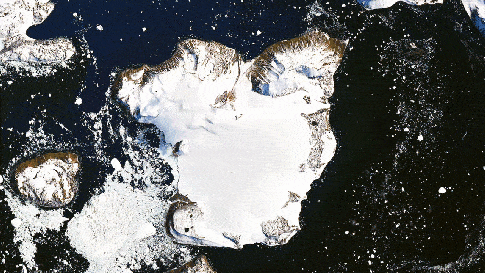
NASA images show a new side of Antarctica, an almost ice-free side. The images show a breathtaking view, and not in the sense that one would have when looking at something beautiful. I am sure it is beautiful, but for our planet, that melted ice has to go somewhere. Just a few days after we wrote about it being warmer in Antarctica than Louisiana, the highest temperatures ever recorded at Argentina’s Esperanza research station arrived: 65 degrees Fahrenheit. The gif image below tells a chilling story that is just heating up.
20% of the snow on one ice cap in Antarctica melted in the heatwave between February 4th and 13th. These images were courtesy of the Operational Land Imager on Landsat 8. They show a drastic before & after visual. Eagle Island was nearly covered in snow on February 4th. By the 13th, you can see that most of the snow has melted, revealing larges amounts of the landmass. In that second photo, you also see a few light blue portions. These represent areas that are now turned into ponds due to the snowpack being saturated with water caused by the melting. The ponds soak up heat more than snow, which accelerates the melting process.
Mauri Pelto, a glaciologist at Nichols College, said, “I haven’t seen melt ponds develop this quickly in Antarctica. You see these kinds of melt events in Alaska and Greenland, but not usually in Antarctica.” This may soon change, since warm temperatures are happening more and more often in Antarctica. The National Snow and Ice Data Center shows that some parts of the area have warmed up 4.5 degrees Fahrenheit since the ’50s.
“And this temperature increase, people talk 2 degrees or 3 degrees — it’s important to appreciate just how sensitive the climate actually is to temperature. It’s important to look at it in terms of absolute temperature, not in degrees Celsius relative to zero. We need to say, what is the temperature change relative to absolute zero. That’s how the universe thinks about temperature. That’s how physics thinks about temperature. It’s relative to absolute zero. So, small changes result in huge effects.”
Elon then gives an example — a visual for those who don’t understand terms such as absolute zero or how it would affect our day to day life. He uses New York City as an example. “So, New York City under ice would be minus 5 degrees. New York City under water would be plus 5 degrees. But looked at as a percentage relative to absolute zero, it’s only a plus/minus 2% change. The sensitivity of the climate is extremely, extremely high. We’ve amplified this sensitivity by building our cities right on the coastline and most people live very close to the ocean.” The reality Elon was pointing out, applied to the case in Antarctica, is that 4.5 degrees of change have a huge impact on the climate.
Pelto gives us a warning of what is to come: “If you think about this one event in February, it isn’t that significant. It’s more significant that these events are coming more frequently.”

























